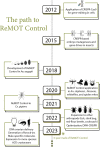The Development and Expansion of in vivo Germline Editing Technologies in Arthropods: Receptor-Mediated Ovary Transduction of Cargo (ReMOT Control) and Beyond
- PMID: 37742320
- PMCID: PMC10755176
- DOI: 10.1093/icb/icad123
The Development and Expansion of in vivo Germline Editing Technologies in Arthropods: Receptor-Mediated Ovary Transduction of Cargo (ReMOT Control) and Beyond
Abstract
In the past 20 years, sequencing technologies have led to easy access to genomic data from nonmodel organisms in all biological realms. Insect genetic manipulation, however, continues to be a challenge due to various factors, including technical and cost-related issues. Traditional techniques such as microinjection of gene-editing vectors into early stage embryos have been used for arthropod transgenesis and the discovery of Clustered regularly interspaced short palindromic repeats and CRISPR-associated protein (CRISPR-Cas) technologies allowed for targeted mutagenesis and the creation of knockouts or knock-ins in arthropods. Receptor-Mediated Ovary Transduction of Cargo (ReMOT Control) acts as an alternative to embryonic microinjections, which require expensive equipment and extensive hands-on training. ReMOT Control's main advantage is its ease of use coupled with the ability to hypothetically target any vitellogenic species, as injections are administered to the egg-laying adult rather than embryos. After its initial application in the mosquito Aedes aegypti, ReMOT Control has successfully produced mutants not only for mosquitoes but for multiple arthropod species from diverse orders, such as ticks, mites, wasps, beetles, and true bugs, and is being extended to crustaceans, demonstrating the versatility of the technique. In this review, we discuss the current state of ReMOT Control from its proof-of-concept to the advances and challenges in the application across species after 5 years since its development, including novel extensions of the technique such as direct parental (DIPA)-CRISPR.
© The Author(s) 2023. Published by Oxford University Press on behalf of the Society for Integrative and Comparative Biology.
Conflict of interest statement
J.L.R. has applied for patent protection on the ReMOT Control technology.
Figures
References
-
- Armstrong GA, Schmidt A, Sandmann G, Hearst JE. 1990. Genetic and biochemical characterization of carotenoid biosynthesis mutants of rhodobacter capsulatus. J Biol Chem. 265:8329–38. - PubMed
-
- Attardo GM, Hansen IA, Raikhel AS. 2005. Nutritional regulation of vitellogenesis in mosquitoes: implications for anautogeny. Insect Biochem Mol Biol. 35:661–75. - PubMed
-
- Beukeboom LW, Kamping A, van de Zande L. 2007. Sex determination in the haplodiploid wasp Nasonia vitripennis (hymenoptera: chalcidoidea): a critical consideration of models and evidence. Semin Cell Dev Biol. 18:371–8. - PubMed
Publication types
MeSH terms
Grants and funding
LinkOut - more resources
Full Text Sources
Miscellaneous


